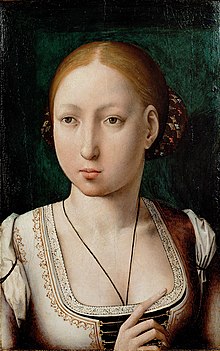Joanna of Castile
| Joanna | |
|---|---|

Portrait by Juan de Flandes, c. 1500
|
|
| Queen of Castile and León | |
| Reign | 26 November 1504 – 12 April 1555 |
| Predecessors | Isabella I and Ferdinand V |
| Successor | Charles I |
| Co-monarchs |
Philip I Charles I |
| Regents |
See
|
| Queen of Aragon | |
| Reign | 23 January 1516 – 12 April 1555 |
| Predecessor | Ferdinand II |
| Successor | Charles I |
| Co-monarch | Charles I |
| Regent | Charles I |
| Born |
6 November 1479 Toledo, Spain |
| Died | 12 April 1555 (aged 75) Tordesillas, Spain |
| Burial | Capilla Real, Granada, Spain |
| Spouse | Philip I of Castile |
| Issue |
Eleanor, Queen of Portugal, and France Charles V, Holy Roman Emperor Isabella, Queen of Denmark, Norway and Sweden Ferdinand I, Holy Roman Emperor Mary, Queen of Hungary and Bohemia Catherine, Queen of Portugal |
| House | Trastámara |
| Father | Ferdinand II of Aragon |
| Mother | Isabella I of Castile |
| Religion | Roman Catholicism |
Joanna of Castile (6 November 1479 – 12 April 1555), called the Mad (Spanish: Juana la Loca), was queen of Castile from 1504 and of Aragon from 1516. From the union of these two crowns modern Spain evolved. Joanna married Philip the Handsome on 20 October 1496. Philip was crowned King of Castile in 1506, initiating the rule of the Habsburgs in Spain. After Philip's death that same year, Joanna was deemed mentally ill and was confined to a nunnery for the rest of her life. Though she remained the legal queen of Castile throughout this time, her father, Ferdinand II of Aragon, was regent until his death, when she inherited his kingdom as well. From 1517, her son, Charles, ruled as king, while she nominally remained co-monarch.
Joanna was born in the city of Toledo, the capital of the Kingdom of Castile. She was the third child and second daughter of Isabella I of Castile and Ferdinand II of Aragon of the royal House of Trastámara. Joanna was a clever and diligent child and an excellent student. Queen Isabella ensured that Joanna, along with her three sisters Isabella, Maria, and Catherine, received a fine education .
Her academic education consisted of canon and civil law, genealogy and heraldry, grammar, history, languages, mathematics, philosophy, reading, spelling, and writing. She read an impressive list of authors of classical literature that included the Christian poets Juvencus and Prudentius, Church fathers Saint Ambrose, Saint Augustine, Saint Gregory, and Saint Jerome, and the Roman statesman Seneca.
...
Wikipedia
